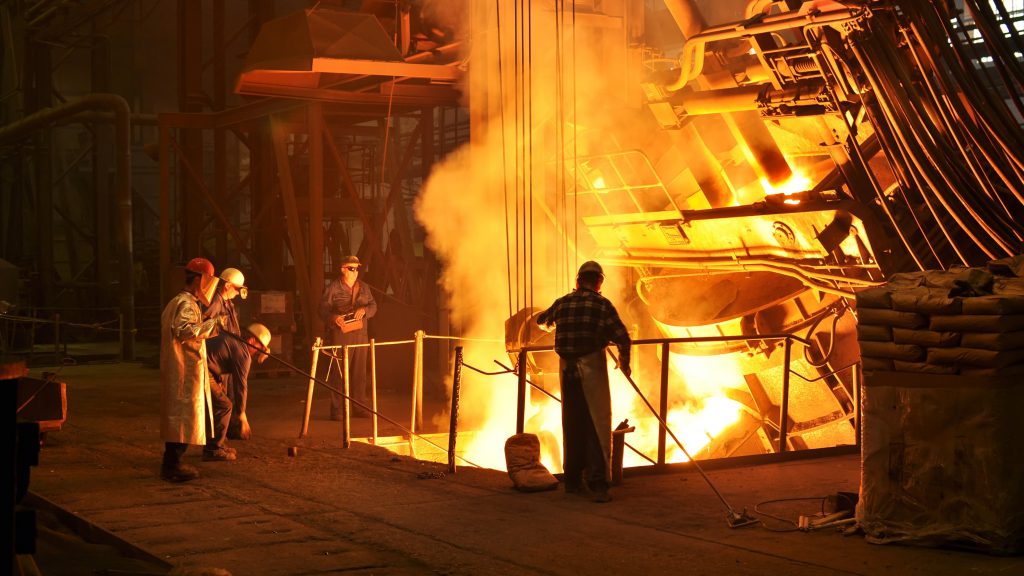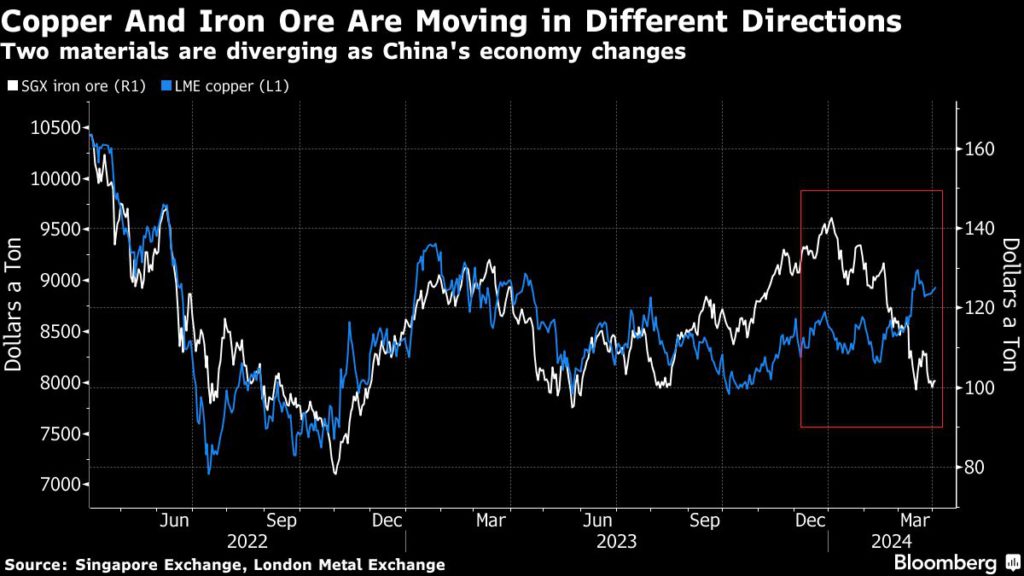Bloomberg News | April 2, 2024 |

Steel mill. Stock Image.
Iron ore’s reset to around $100 a ton is indicative of a broader reshaping of China’s commodities markets that favors the new economy over the old.

The steelmaking material plunged to $95.40 a ton on Monday, a 10-month low, before nosing back into three figures, testimony to the damage still being wrought by a years-long property crisis that appears far from over. In early January, Singapore futures hit $143.50 a ton, their highest since June 2022. They last traded at $100.85, marking a 30% slump.
Iron ore’s weakness comes amid tentative signs that the wider economy is beginning to heal. Factory activity snapped a five-month contraction in March, beating estimates and adding to modest signs of recovery.

That divergence between a manufacturing-led upswing and a languishing property market is likely to deepen as Beijing pursues new drivers of growth in sectors like renewable energy and advanced technology. At its peak in 2018, real estate accounted for nearly a quarter of China’s economy, according to Bloomberg Economics. Now it’s less than a fifth.
Property still makes up the bulk of steel demand. But Beijing has held off on delivering the degree of fiscal stimulus — principally infrastructure spending — that could fully offset the housing crash. Ballooning debt levels at local governments are one obstacle. Meanwhile, the usual lift to construction activity in the spring has also failed to properly materialize, creating uncertainty over when consumption might revive.
China’s mills including Angang Steel Co. and Maanshan Iron & Steel Co. reported worse-than-expected net losses in their 2023 earnings reports. Maanshan warned that conditions “will remain grim due to the mismatch between supply and demand in 2024.”
All to say, President Xi Jinping’s crackdown on property and his drive for “new productive forces” could well herald an era in which iron ore and steel play a lesser role to the metals set to benefit from the energy transition.
Structural shift
“It’s understandable if the weakness lasts for a week or two,” said Cao Ying, chief ferrous metals analyst at SDIC Essence Futures Co. “Any longer than that and the market will start to adjust its expectations as it will look more like a structural shift.”
Iron ore can’t stay below $100 a ton for too long without higher cost producers shutting up shop. That would thin out supply and put a floor under prices in the near term. But it’s the long-term demand side of the equation that’s causing most concern. The government in Australia, China’s biggest supplier, expects free-on-board prices of $95 a ton this year, $84 next year, and then levels in the $70s out through 2029.
The market’s crash contrasts starkly with another commodities bellwether, copper, which is closing in on a yearly high. Supply issues are the immediate driver, but the metal’s central role in the energy transition is driving predictions of outsized gains in the years to come. Steel and iron ore markets just won’t enjoy the same level of support from that secular shift in commodities consumption.
“There seems to be no end to the real estate crisis, local governments can’t sustain current investment levels, consumers are still very cautious,” said Tomas Gutierrez, analyst at Kallanish Commodities Ltd. There should be a seasonal demand recovery in the second quarter, “but this is not likely to be strong enough to really turn markets around,” he said.
Copper price rallies amid rising optimism on Chinese economic outlook
Bloomberg News | April 2, 2024 |

Stock image.
Copper rallied back above $9,000 a ton as investors weighed upbeat factory data from top consumer China and the potential for output cuts by the country’s leading smelters.

Investors are becoming more optimistic about the world’s second-largest economy after the official manufacturing purchasing managers index in March registered the highest reading in a year, the latest green shoot alongside strong exports and rising consumer prices. A factory gauge in the US also unexpectedly halted 16 straight months of decline.
“The economic data is aiding market sentiment, signaling a recovery in manufacturing industry,” analysts at Galaxy Futures wrote in a note, adding the trend supports consumption of raw materials like copper which is facing potential supply-side constraints
China’s smelters, which produce over half the world’s refined copper, are considering output cuts after processing fees fell to near zero.
Still, the solid US factory data reinforced speculation that the Federal Reserve will be slow to cut interest rates, which could weigh on the outlook for commodities. Bond traders have priced in less easing by the Fed this year and briefly set the odds of a first move in June below 50%.
Copper climbed 1.5% to $9,000 a ton on the London Metal Exchange by 4:15 p.m. local time, after earlier rising as much as 2%. Aluminum jumped as much as 2.2% to $2,387.50, its highest level since January. Zinc rallied 1.8%, as all metals except lead rose.
(By Annie Lee)
No comments:
Post a Comment